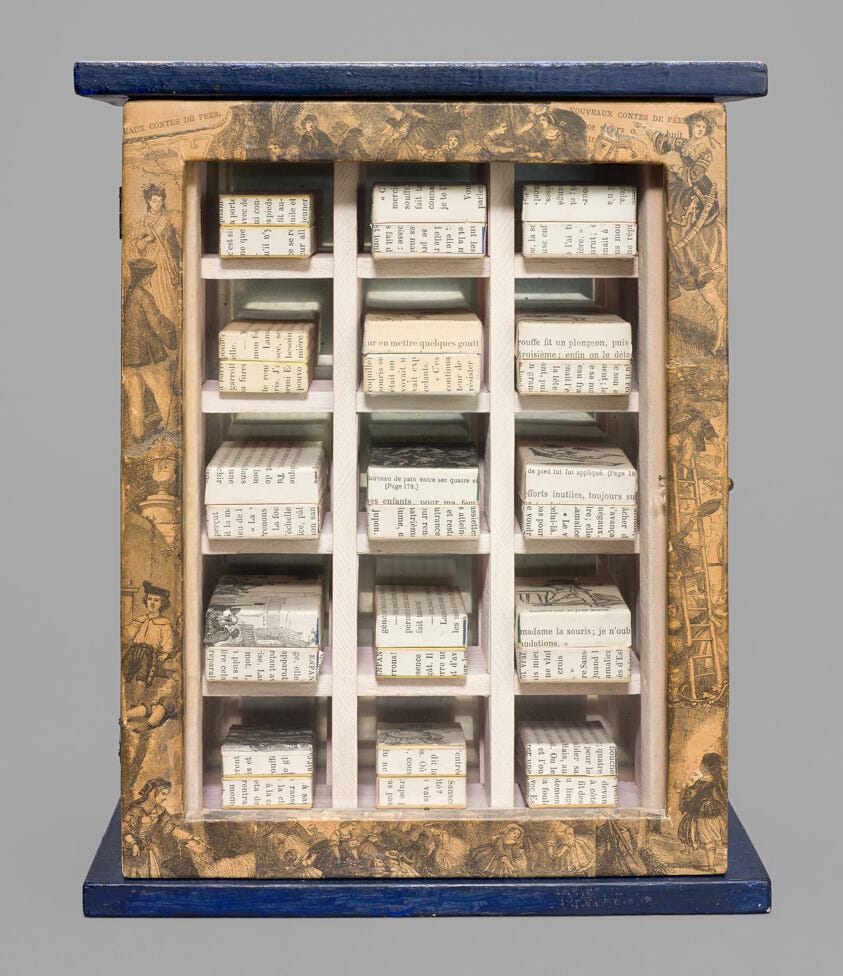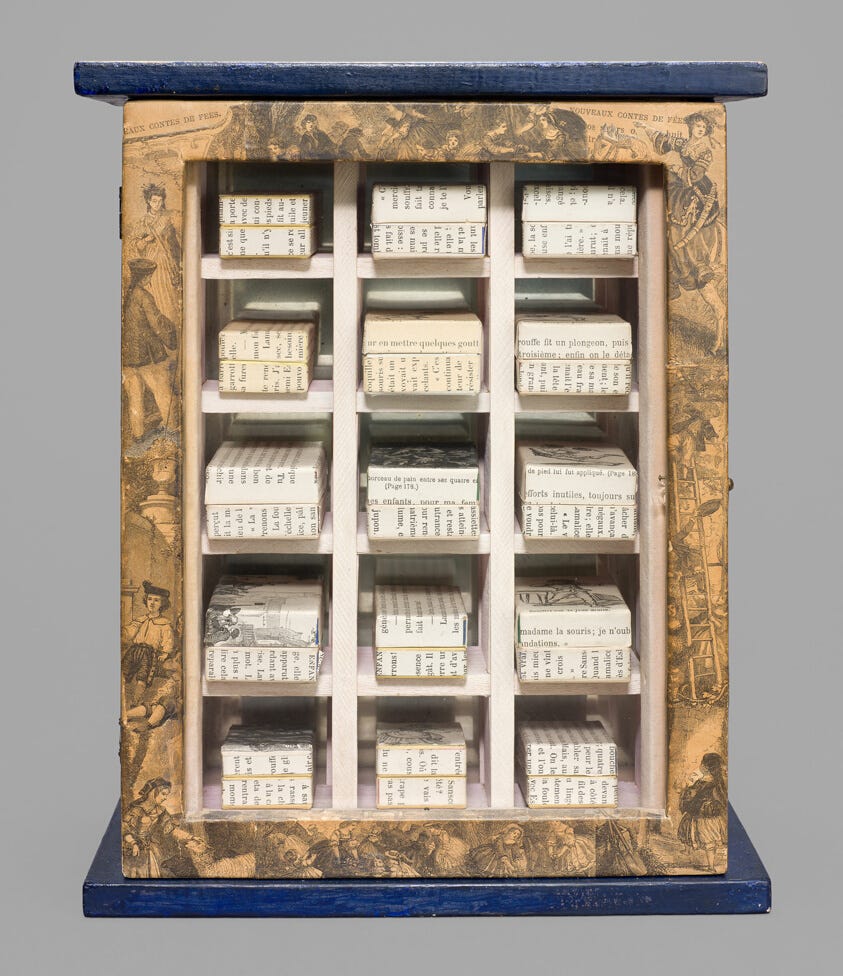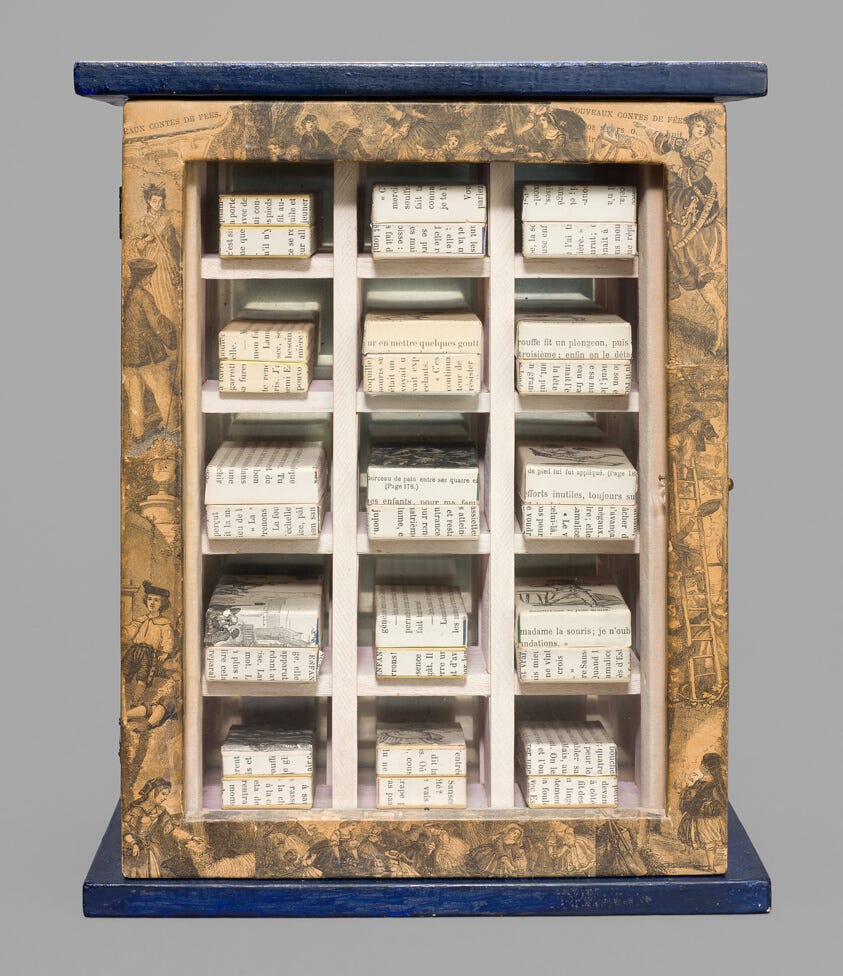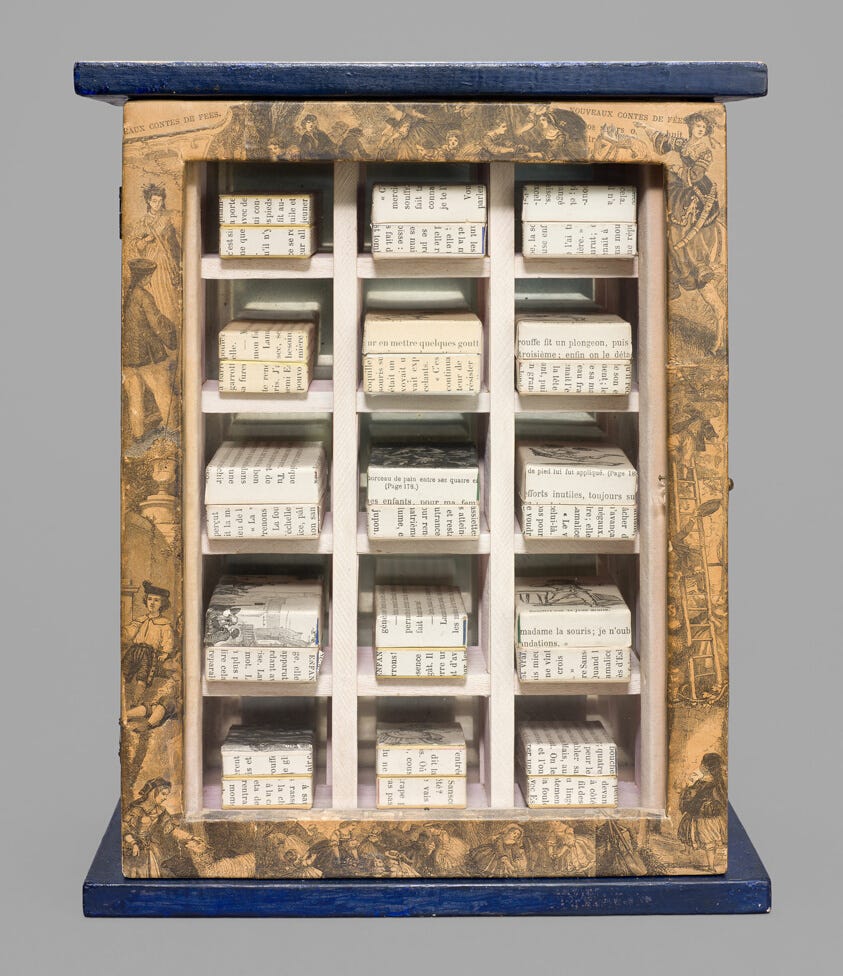What Is Outwardly Small and Inwardly Vast?
A literature professor, an architect, and a Zen student consider infinity in the presence of artist Joseph Cornell’s "Nouveaux Contes de Fées (New Fairy Tales)."

This collaborative post is appearing on Tara Penry’s ,
’s , and ’s . The introduction is by Tara Penry.Note to Tara’s Subscribers: Today’s post is a special edition (and addition). For newcomers here, Monday is our usual day to post, but I am enchanted by pondering a piece of art in company with others. Please join us if you like and share with us in the comments any thoughts of your own on this artwork, or inner vastness, or collaboration.
The wooden box contains fifteen small openings, three across by five down. The openings contain small boxes made of folded paper, each bottom fitted with a matching lid. The paper contains printed words and pictures. The printed matter and the folded boxes contain — what? A new fairy tale? Something even more vast?
Last month the artist and senior Zen student Sal Randolph wrote a column for
about the books we carry around and keep close for their “secret well of energy.” She called these “talisman books” and discussed one of her favorites, Charles Simic’s collection of poetic essays, Dime-Store Alchemy: The Art of Joseph Cornell. Like the unique and imaginative diorama boxes of Joseph Cornell, a talisman book, according to Sal,is outwardly small and inwardly vast. It should function like an oracle when you open it at random. It should contain a multitude of ideas and images and its language should spark and inspire. It should hold your most secret aspirations in object form. (The Books That Made Us, Sept 21, 2023)
While reading Sal’s post, Julie Gabrielli and Tara Penry were both attracted to the idea of the “talisman book” full of inspiration and association, and the phrase “outwardly small and inwardly vast” sparked our imaginations.
In the conversation that followed, we three decided to choose one of Joseph Cornell’s boxes (above) and write – each of us separately – about what it meant to use the phrase “outwardly small and inwardly vast” in reference to this talismanic object.
The box pictured above, Nouveau Contes de Fées (New Fairy Tales), spoke to Tara of enchantment, from the blue frame-wood that reminds her of the deep, cold, mysterious part of a mountain lake, to the fragments of illustration: boys on a ladder; a woman sitting side-saddle on a horse, armed with a sword, and pointing like a general; a Chinese man in traditional dress having some sort of discourse with a woman — a courtship, possibly?
The boxes within boxes within a box frame suggested to her the stillness and mystery at the point where a rock drops in a lake, along with the expanding circles around it, with a chance of touching anywhere. There is no telling what’s below the blue surface of the lake, how far the stone has to fall to reach the bottom; no telling what’s inside those folded paper boxes.
Why are we doing this?
We wanted to honor Sal’s notion of the “talisman” and the artist Joseph Cornell, and to see what would come up when we gave ourselves a common task.
The objective is fundamentally artistic: What do our unique perspectives see, and how can we communicate that?
It is also ecological, like the systems that Julie writes about: What can a collaboration like this reveal about the connections between the thoughts of three people in different U.S. states who without this writing platform would be strangers to each other?
It is experimental and practical: If three of us reflect on the inner vastness of the same object, will it change your inclination, dear reader, to see inner vastness in your world today? Would it be different if only one of us had written? Does the collaboration itself open up an extra door upon the vast innerverse? See what happens, and let us know in the comments.
On a practical note, you’ll find a button linking you to each collaborator’s home page after their contribution to the post. We recommend you read the whole post first, and then use the buttons if you want to see more of that writer’s work. We place them mid-post so you can keep track of who is who, but we only recommend using them at the end.
We hope you enjoy our three reflections on the inner vastness of Nouveau Contes de Fées.
You, Box
By Tara Penry ( )
You --
Box, all
straight spine,
blue hat, and matching blue
slipper
I ask you
what's inside?
And I wait
because
you look like someone who
takes
your time.
While waiting
I
paint a little flower
on the back of my
left hand. I gaze
out the window
this orange
leafy
afternoon. I change
positions
in my chair
and then
yawning
change chairs.
I watch a leaf
detach itself and fall,
a fairy frigate
to the pile of leaves
where everybody
wants to land.
In the long silence
the shadow of my tallest tree
moves up the yellow wall
and -- silly me --
I don't know
where to find
your answer.
You probably don't
email.
You, Box, little tower of
quadrilaterals.
I am not going to touch you,
but somehow,
I'd like to have a conversation
with you
about --
you know --
what's
inside.
Fifteen Ways of Looking at Joseph Cornell’s New Fairy Tales
By Julie Gabrielli ( )
I A button collection Earrings for half a month Guitar pick storage II Base pigments for rare pottery glazes Pantone color samples arrayed in a rainbow around the whites Rare earth mineral collection Grains of crushed calcite, spices, pollen, soil and soot, organized dark to light Pencils ranked by lead hardness, 9H to 9B Line drawings of whales arranged by size III Nuts sorted by shape Pizza topping recipes, even Hawai’ian Wine-tasting notes Kitchen tool wish list IV Grocery list for a puzzle-lover Energy-saving tips Hypo-allergenic cat breeds Workaholic’s bucket list Choices of dangerous outdoor adventures Four-year-old birder’s Life List V Gardener’s diary Daily journal after giving two-week’s notice Memories of a lonely child’s first fifteen years Travel memoir of a homebody VI Little Library prototype First draft of Gregorian calendar First draft of zodiac First draft of periodic table Failed prototype for the Schoenberg Scale VII Sewing box for an ambitious wordsmith Museum guard’s worry boxes Agnostic grocer’s childhood prayers Converted Buddhist’s Lojong collection VIII Forgetful person’s Advent calendar Decades of fashion history from the 1870s Child-rearing advice from moms who’ve “been there” IX A barber’s cabinet of ideas Catalog of Etsy coasters Podcast episodes storyboard Surreal song lyrics generator Medicine cabinet for the adventurous X Spontaneity machine for an anxious person Optometrist’s memory palace AI defiance device Word salad bar XI Inuit words for clouds Japanese words for tree spirits French words for love English words for emotions XII Cricket condo Refugee housing for fairies displaced by a clearcut XIII Reasons for moss Reasons for mosquitoes Reasons for mortality XIV Apocalypse survival guide Avalanche survival guide Friendship-with-ex survival guide XV Pipeline activist’s manifesto Neolithic settlements refuting theories that hierarchy is inevitable Biographies of future social justice warriors Viable alternatives to capitalism
Nouveaux Contes de Fées
By Sal Randolph ( )
A girl and her parents were traveling and they stopped one night in an old hotel. At one time this was the kind of thing we called a nouveau fairy tale; now we would call it an old tale, set in a time before. A girl, as these tales go, is capable of wanting. She watches the sky and follows the motions of birds with her eyes. Clouds speak to her in cloud-language. Let us begin here, then. Let us give her a name: Violette, perhaps. So, Violette and her parents were traveling and they stopped one night in an old hotel. Entering, they stepped into a grand hall of dark wood where shadows gathered in the corners of the high ceiling. Violette began to grip her small hands, one with the other. The large head of a stag was mounted on the wall, and she thought she saw its mouth open as if it was about to speak. Just then, the hotel-keeper came to take them to their rooms. Violette’s parents were given a room with a four-poster bed, a fire, and a braided rug. Through a door was Violette’s room, smaller and plain, with a single eight-paned window. When it was time to sleep, Violette lay on her bed looking up, as if she could see the night sky through the timbers of ceiling and roof. She willed her eyes to stay open. Look at the stars, she said to herself, look at the moon. Scraps of cloud fled before the high winds. Violette flew with them. She looked for a familiar place in the forest below. So many trees, dancing in the dark wind. In a clearing, she saw the stag. Wondering what he had wanted to say, she set down near him. The coarse hair of his coat glimmered in the moon’s light. His great antlers dipped and he opened his mouth. Just then, the door to Violette’s room opened. The mother was looking in on Violette’s sleep. Light poured through the crack in the door, and the stag was lost, and with him the night sky, the moon, the wind. Mama? Violette said. Sleep, said her mother, closing the door. Violette felt herself: an ordinary girl in a nightgown in a bed in a dark room in a hotel in a forest. Lying awake she began to search for a story to be her companion. The mermaid who came on land? No. The children sent out alone in the woods? Not that one. The princess who fell asleep for a hundred years? None of these. She needed a new story, a story about a journey, a story about wanting. A girl and her parents were traveling, and they stopped one night in an old hotel.
This post was a special collaborative feature. If you enjoyed it, be sure to hit the Like button below. We also welcome your comments about how this collaboration and this box by Joseph Cornell landed with you!
Or jump to
or or home pages to explore our usual writings.









Your question of whether the three reflections would change my inclination today, to see the inner vastness, is interesting as due to weather conditions I am confined to a small writing sanctum. A box if you will, one in which I often feel constricted by its confines.
Reflecting on your words, being patient when my own wouldn't come, observing through the window the outer vastness of the natural world, turning back to the screen, I reflected on the inner vastness of this tiny box, filled with literature, some read, some passed on, some to yet be discovered, their secrets yet to be revealed, and then the vast world of ideas, contained during inception, unready to be released, while I hope for their conversation with me.
I will never see my box in the same way again!
I remember reading that particular edition of the Books That Made Us, I think my favourite and it did get me thinking about the idea of a book as a talisman. It was good to be reminded of that again, in addition to this extraordinary collaboration. Congratulations to all!
This is magnificent in every way--the collaboration, the writing, the expanses the three pieces open, the inner generative wonder. Truly extraordinary. Bravo! And it strangely renders me without words but wandering silently across an inner landscape of images, as if each box is another universe, a blank space of possibility.